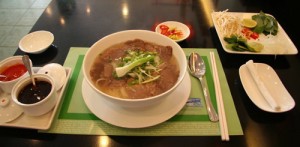
Like so much else in Vietnam, the cuisine reflects long years of cultural exchange with China, Cambodia and, more recently, France. As elsewhere in Southeast Asia, rice is the main staple, though bread – especially baguettes introduced by the French – is ubiquitous and usually very good.
Dishes are generally served at the same time rather than by course, and eaten with long-grain rice, nuoc mam or fish sauce, and a wide range of fresh herbs and vegetables. Meals are generally eaten with chopsticks or, if European food, with knife and fork.
Yin and Yang
In Vietnam, meals are typically comprised of some permutation of five components: a sour salad, a salty fish of meat dish, white rice, soup and a vegetable. The meal ushers diners through a full range of flavors and creates balance between yin and yang foods.
Yin foods are warm and wet, while yang foods are dry and crisp. The reason for mixing yin and yang might be to experience the pleasure of textures, but it also provides your body with a combination of food types that keep it running in optimal condition.
Some of the more popular Vietnamese dishes include Nem: small-spring rolls’ of minced pork, prawn, crab meat, fragrant mushrooms and vegetables wrapped in thin rice paper and then deep fried.
Another dish eaten in a similar fashion is cuon diep, or shrimp, noodles, mint, coriander and pork wrapped in lettuce leaves. Hue, a city associated with Buddhism, is famous for its vegetarian cuisine and for its banh khoai, or ‘Hue pancake’. A batter of rice flour and corn is fried with egg to make a pancake, then wrapped around pork or shrimp, onion, bean sprouts and mushrooms. Another Hue specialty is bun bo, or fried beef and noodles served with coriander, onion, garlic, cucumber, chili peppers and tomato paste.
Soups are popular, and generally served with almost every meal. Mien ga is a noodle soup, most popular in the south, blending chicken, coriander, fish sauce and scallions. Hu tieu is chicken, beef, pork and shrimp served with a broth over rice noodles mixed with crab meat, peanuts, onion and garlic. Canh chua, a sour soup served with shrimp or fish head, is a fragrant blend of tomato, pineapple, star fruit, bean sprouts, fried onion, bamboo shoots, coriander and cinnamon. Perhaps the best known of all Vietnamese soup dishes, often eaten for breakfast or as a late night snack, is pho, a broth of rice noodles topped with beef or chicken, fresh herbs and onion. Egg yolk is often added, as may be lime juice, chili peppers or vinegar. Pho is generally served with quay – a fried piece of flour dough.
The Herb for What Ails You
Comment herbs and seasonings in Vietnamese food are believed to provide a host of health benefits: spring onion for digestion and respiratory tract infections; coriander to strengthen the stomach, stimulate discharge and reduce fever; dill to protect against free radicals, carcinogens and bone loss and betel leaf to stop cell degeneration
Fruits, desserts and drinks
A wide range of fruit is available, including many lush tropical fruits such as mango, custard apple, sapodilla, durian, pineapple, star fruit, and rambutan. More temperate fruits such as apples, cherries and strawberries can be found in the north.
Bottled fresh water, canned and bottled soft drinks and a wide range of canned beers are available throughout the country. French and Australian wines are increasingly popular, especially at French restaurants. Local rice liquors are cheap and fierce; as a legacy of Vietnam’s recent history Stolychnaya and other Russian vodkas may be found on some shelves.
Many people say Vietnamese Coffee is a MUST TRY when you are there. As Vietnam is the second largest coffee producer so you can find coffee powder almost everywhere. Real Vietnamese coffee is best brewed the traditional way – coffee grounds are placed on an aluminum filter that sits on top of a cup. Hot water is then poured over the grounds and the coffee drips slowly. This creates an extremely dense, strong tasting cup that requires a few teaspoons of sugar or condensed milk. In fact, if you order an iced coffee, the sugar will usually be put in be whoever is making the brew. You can order hot coffee, which usually comes in a cappuccino sized cup. However, Viet Nam being a tropical country, coffee is almost always taken iced. The ice cuts the strong taste a little, while giving the drink a crisper edge.
In Vietnam, probably Bia Hoi is the cheapest beer in the world. Bia Hoi is beer that’s freshly brewed every day and distributed to the many small bars that line the city streets. Its served warm from the keg and then poured over ice. In Hanoi and Ho Chi Minh City you’ll find little bars selling Bia Hoi everywhere. Many of these places serve food, though local vendors come by hawking peanuts, rice cakes, and other snacks. This is the quintessential experience that every visitor must have at least once. Things get rowdy later on at many of these places, so enjoying a couple of liters earlier in the evening is a good idea.
Travel in Vietnam and enjoy eating adventure!